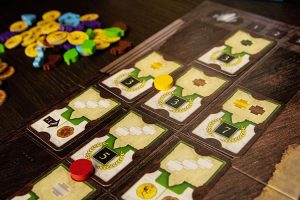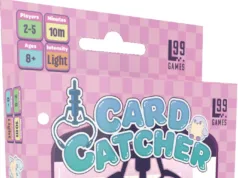 Carpe Diem is one of those great Latin phrases that somehow just stuck around as part of the vocabulary of English speakers. Maybe it’s just the succinctness of Horace’s expression on the importance of the present that translating it lost too much of what made it special.
Carpe Diem is one of those great Latin phrases that somehow just stuck around as part of the vocabulary of English speakers. Maybe it’s just the succinctness of Horace’s expression on the importance of the present that translating it lost too much of what made it special.
What does that have to do with this board game? Beats me. It’s sort of set in Roman times, presumably? Look, Carpe Diem is the newest medium weight euro from famed designer Stefan Feld. If you are looking for a theme you’ve taken a wrong turn. But let’s dig into what makes Feld special—game mechanisms and points for everyone!
Gameplay Overview:
In Carpe Diem you’ll be placing building tiles on your own district of Rome, trying to complete buildings to earn…well, stuff. If you complete a landscape, you’ll earn a resource of that type (leaves from green landscapes, chickens from brown, etc…). There are also dwellings that give you a special ability when completed. For instead the baker awards you some bread tokens and the craftsman building allow you to take an additional tile from the bottom of the main board.

So, while your goal is simple you can’t just grab any tile you want. The main board is divided into seven sections, each given four tiles at the beginning of the round. Each turn you can only move your player piece to an adjacent section, and you must choose one of those tiles to add to your district. You must place adjacent to already existing tiles as you go, so getting the right tiles at the right time is crucial.
After seven rounds there is a scoring phase. During setup, scoring cards are laid out in an array on the board. Each player must choose two adjacent cards to score and place one of their discs there, preventing others from scoring. Each card may have different requirements—certain resources, several buildings, or maybe specific types of completed buildings. You can potentially score each card multiple times if you meet its requirements more than once. If you are unable to fulfill the requirements of a card you’ve chosen, you’ll lose four points.
The gameplay picks back up with adding new tiles to the main board and players continuing to build out their districts. There are three additional scoring phases, but no new cards ever get added, so eventually whoever places last in the final round has no choice on which cards they must score. Once all scoring has been completed after the fourth phase the game ends and whoever has the most points is the winner!

Game Experience:
Let’s start at the top. I love the scoring mechanism in Carpe Diem. Creating pairs of cards that must be scored together and if you can’t score one of them, you’ll lose points for it…amazing. And the scoring combinations are set at the beginning and never change, so you’ll be able to plan around them and every game will feel considerably different. It’s even possible that you can score the same card in all four scoring phases if it’s in the middle and no one else takes the surrounding areas (although this seems unlikely).

The potential downside here is how mean that can be. There is a “banderole” track that determines the order players get to choose their scoring cards each round. You move up this track by building on certain spots on your player board—giving you some reasons to maybe place what would otherwise be suboptimally in order to get the first pick of the scoring cards. Building a strategy around very specific cards can be a recipe for disaster. If it’s not available, you’ll still have to choose somewhere to place a scoring disc and if you aren’t prepared with a plan B this can cost you a lot of points.
The actual building of your districts is somewhat less interesting. Your district is surrounded by a frame that gives you additional points if you construct a building in the right row or column. So, you’ll move left and right gobbling up tiles trying to set yourself up for the scoring phase. You can spend bread tokens you’ve acquired to break the “normal” movement rules and move to anywhere if there is a very specific building you need. But you’ll likely be saving these for the scoring phase.

It’s worth noting also how hideously ugly this game is. Castles of Burgundy gets a bad rap for its drab browns and greens. Carpe Diem uses basically the same color palette. The lack of theme here is really a shame too. Eurogamers may not be a “theme-first” crowd, largely, but there is nothing here to even try to grasp onto. I had to beg my local group to get this one to the table. There is no way to explain the game in a way to make it sound interesting. And no way to experience the game in a way that it feels like anything other than an accumulation of points.
Final Thoughts:
Carpe Diem is a solid medium weight euro. But it is so reminiscent of Castles of Burgundy that it is difficult to recommend. The scoring card mechanism is great, but the acquisition and placement of building tiles as the main game mechanism just isn’t exactly captivating.
If you are a Feld completionist—well, you probably already own it. If you wish Castles of Burgundy had more opportunities to directly mess with your opponent’s scoring abilities you might find Carpe Diem better suited to your tastes. Otherwise, it doesn’t really set itself apart drastically and feels like a slightly worse tweak of a euro classic.
Final Score: 3 Stars – A solid tile placement euro, but theme less and ultimately not as good as similar games.
 Hits:
Hits:
• Scoring pairs of cards is a great mechanism.
• Lots of depth of decisions as you must achieve multiple scoring goals each round.
Misses:
• Theme less and boring-looking
• Tile placement choices aren’t incredibly interesting.
• Scoring can be exceptionally mean.























